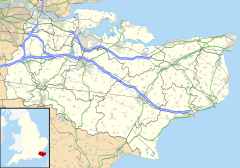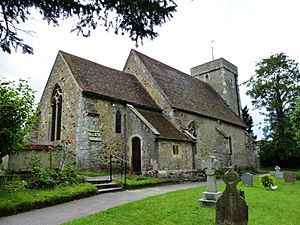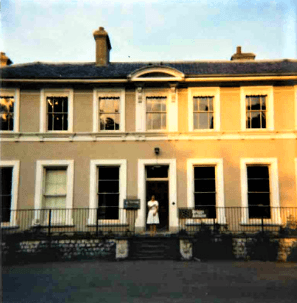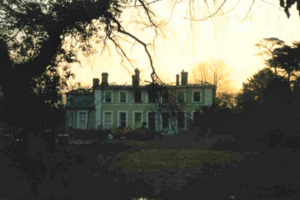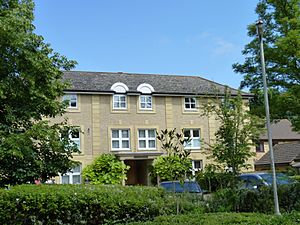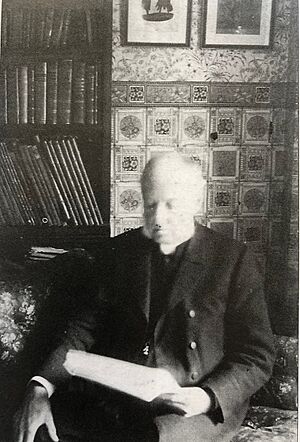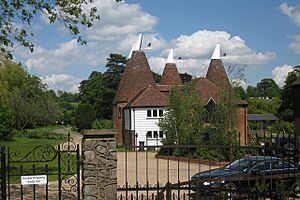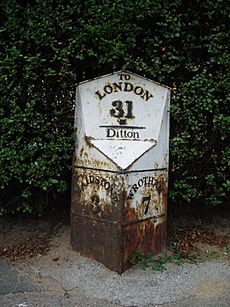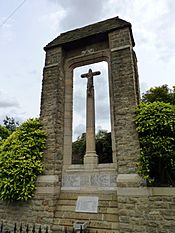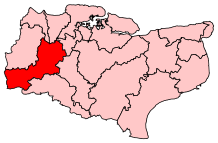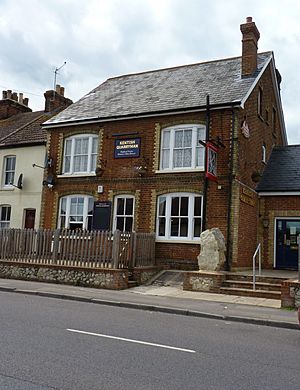Ditton, Kent facts for kids
Quick facts for kids Ditton |
|
|---|---|
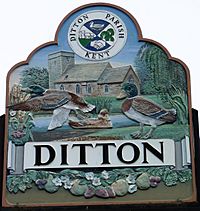 Ditton Village Sign |
|
| Population | 4,786 (2011) |
| OS grid reference | TQ 71038 58464 |
| • London | 31 mi (50 km) WNN |
| Civil parish |
|
| District | |
| Shire county | |
| Region | |
| Country | England |
| Sovereign state | United Kingdom |
| Post town | Aylesford |
| Postcode district | ME20 |
| Dialling code | 01732 |
| Police | Kent |
| Fire | Kent |
| Ambulance | South East Coast |
| EU Parliament | South East England |
| UK Parliament |
|
Ditton is a large village and civil parish (a local government area) in Kent, England. It's part of the Tonbridge and Malling area. The village is about 4.6 miles (7.4 km) west-northwest of Maidstone and 1.8 miles (2.9 km) east of West Malling.
Ditton is long and narrow, stretching across the A20, which was once the main road from Dover to London. To the south, you'll find farmland, and to the north, there's more industry. It sits in the Medway Valley, on the northern edge of the Kent Weald. In 2011, Ditton had a population of 4,786 people.
Contents
History of Ditton Village
The village of Ditton grew up around a stream that powered many corn mills. The first time Ditton was written about was in the Domesday Book in 1086. This book was a huge survey of England ordered by William the Conqueror.
Today, Ditton has several listed buildings (important historical buildings). These include a church from the 12th century, an old mill house, and two oast houses (buildings used for drying hops).
In more recent times, industries like ragstone quarrying (digging up a type of stone) and newsprint (paper for newspapers) became important. These industries provided many jobs for local people. The village also grew a lot as people moved from nearby Maidstone. Now, Ditton has a mix of farming and industry, along with many places for fun and social activities.
What Does "Ditton" Mean?
The name Ditton comes from an old Saxon word, "Dictune." This means "the village on the dike" or "trench of water." This name comes from the Bradbourne Stream, which starts near East Malling and flows through the village. This stream used to supply water to the large Aylesford Newsprint factory, which was once the biggest paper recycling factory in Europe.
Early Life in Ditton
We don't have much information about the very first people who lived in Ditton. However, some ancient tools have been found here. These include a stone axe and other flint tools from the Mesolithic period (Middle Stone Age). People have also found Iron Age pottery and signs of pit dwellings (simple homes dug into the ground) in the Holt Hill area.
An Anglo-Saxon spearhead was discovered in 1962 in a sand hill at Cobdown, Ditton. It might have come from an old grave that was destroyed.
Ditton in the Domesday Book (1086)
The first official record of Ditton is in the Domesday Book from 1086. Back then, the village had 31 homes. The book says that Haimo the sheriff held "Dictune" for the Bishop of Baieux (Bayeux). It had land for farming, a church, servants, a mill, meadows, and pasture. There was also wood for feeding pigs.
There was another estate (a large area of land owned by a lord) in Ditton called Sifletone. This also belonged to the Bishop of Baieux. It had land for farming, servants, a mill, meadows, and pasture.
So, in 1086, there were three main estates in Ditton: Ditton Manor, Brampton Manor, and Sifletone. All of them were owned by Odo, the Bishop of Bayeux, who was the half-brother of William the Conqueror. Later, Odo was imprisoned, and his lands, including Ditton, were taken by the King.
Ditton's Historic Buildings
Ditton has a ford (a shallow place to cross a river or stream). Both the ford and St Peter's Ad Vincula Church are in a special conservation area. The church was built in the 12th century, and its tower was added in the 14th century. The first bell in the church was hung in 1656.
In 1711, it was noted that every acre of woodland in Ditton had to pay a special tax to the church. In 1798, Ditton was part of the Diocese of Rochester (a church district). The church was repaired in 1860 by a famous architect, Sir George Gilbert Scott.
Inside the church, you can see old glass from the 14th century. There are also old wall monuments and a plaque with a picture of a ship from Nelson's time. The mill mentioned in the Domesday Book, called Church Mill, was near the ford and closed around 1912.
Ditton Place and Other Manors
Ditton Manor included a large house called Ditton Place. This house was built in the late 1500s. It was owned by several families over the years, including the Golding family. An organ built by the famous John Avery was moved to Ditton Place in the late 1700s.
The last Golding family member to live there died in 1856. Later, Rev. John Young Stratton, who worked to help poor people in the countryside, bought it. Sadly, Ditton Place was destroyed by a fire in 1987. Today, modern homes stand where it once was, and one of the roads is named after the old house.
Ditton Court was another important house near St Peter's Church. "Court" is a word often used in Kent instead of "Manor." This was where the Lord of the Manor of Ditton would sometimes hold court to decide local issues. Ditton Court was taken down in 1972 to make way for new homes.
Brampton Manor likely stood where the New Road Industrial Estate is now. Sifflington Manor was another estate in Ditton that eventually became part of Ditton Manor.
Borough Court was another manor house in the northern part of Ditton. It was owned by the Culpepper family. One famous person connected to this family was Joyce Culpeper, whose daughter was Catherine Howard. Catherine Howard later became the fifth wife of King Henry VIII.
Who Were Ditton's Famous People?
Ditton has been home to several interesting people throughout history.
- William Kempe was the parson (a type of priest) of Ditton in 1534. He was sued for being away from his parish.
- The Rev. John Young Stratton (1829–1905) was a writer and social reformer. He was the Rector of Ditton for 48 years. He worked hard to improve the lives of farm workers and hop-pickers. He even suggested a system like today's welfare state. He also helped restore St Peter's Church in 1860.
- William Boghurst was a local apothecary (like a pharmacist) from Ditton. He stayed in London during the Great Plague of London in 1665, treating many patients. He wrote a book about his experiences.
- Thomas Tilson was the rector of Ditton from 1679 to 1702. He was known for sharing a strange story about a woman who appeared as a ghost to a nurse. His memorial in St. Peter's Church shows a gift he left for the poor.
- Reverend Samuel Bishop (1731–95) was a poet and headmaster. He was also the rector of Ditton. His book of poems was very popular after he died.
- Thomas Golding was the sheriff of Kent in 1703. He owned Ditton Place for a time.
- John Golding (died 1807), a relative of Thomas, is believed to have discovered the "Goldings" variety of hop, which is named after his family.
- Lt. Col. Clifford Sheldon was a director at Reeds, a paper manufacturing company. A club house, which was once an oast house, was named after him.
- Edward Humphreys (1881–1949), known as Punter Humphreys, was born in Ditton. He was a professional cricketer for Kent County Cricket Club.
- Charles Hooman (1887–1969), also known as Chubby Holman, was born in Ditton. He was an amateur sportsman who played cricket, golf, and rackets. He even played golf for Great Britain and Ireland.
- Barry Hawkins (born 1979) is a professional snooker player from Ditton. He has won a major snooker title and has been ranked among the top players for many years.
The Old Turnpike Road
The A20 road that goes through Ditton was once a turnpike. This means people had to pay a fee to use it. These roads were built to connect London with Dover. Along the road, you can still see old milestones (markers showing distances) made of cast-iron. The one in Ditton is a listed building, meaning it's protected for its historical importance.
How Ditton's Population Grew
In 1663, Ditton had 218 people. By 1831, it had 192 residents. The population slowly grew to 235 in 1851 and 255 in 1872, with 51 houses. The population has grown much more since then, reaching 4,786 in 2011.
Schools in Ditton
The Ditton Church School was started in 1853 for 70 children. It was made bigger in 1887. A separate infant school opened in 1973.
Today, Ditton Infant School is for children aged 4 to 7. It shares its site with Ditton Church of England Junior School, which is for pupils aged 5–11.
Aylesford School – Sports College is a secondary school nearby for students aged 11 to 18. It's a Sports College, so sports education is a big part of its curriculum.
MidKent College is the closest college for further education. It offers many different courses for students aged 16 and older.
The Ditton Heritage Centre is in an old Victorian building. It has a classroom set up like a Victorian school, so children can learn what school was like long ago.
Ditton War Memorial
Every year on Remembrance Sunday, a parade takes place in Ditton to remember the soldiers who died in World War I (22 names) and World War II (7 names). The parade ends at the War Memorial, where a wreath is laid.
The monument was designed by Gilbert Scott, who also gave the land for it. It's special because of the roof over the cross. It was officially opened on September 26, 1920. The monument was given listed building status in 2000, which means it's protected.
Important Buildings in Ditton
Many buildings in Ditton are "listed," meaning they are historically important and protected.
- 40, The Stream, Ditton, Kent (Grade II)
- 578 London Road, Ditton, Kent (Grade II)
- Church of St Peter Ad Vincula New Road, Ditton, Kent (Grade II*)
- Golding Tomb 15 Yards South of Ditton Church (Grade II)
- Golding Tomb 20 Yards South East of the Chancel of Ditton Church (Grade II)
- Stream Cottages 44–48 (Grade II*)
- Milepost on the A20 London Road, Ditton, Kent
- The Clifford Sheldon Club House, Cobdown Close, Ditton, Kent (Grade II)
- The Old Mill House, 51 The Stream, Ditton, Kent (Grade II)
- War Memorial, 1 New Road, Ditton, Kent (Grade II)
Geography of Ditton
Ditton's history has been shaped by its natural resources, like water, soil, and rocks. Its location near major roads and railways to London also helped it grow. Today, the north of the parish has industrial areas, the middle has homes, and the south has fields and woods.
Ditton is in the Medway valley and borders the River Medway to the north. The Medway is Kent's main river. It flows past Ditton and eventually joins the River Thames near Sheerness.
[[wide image|Ditton from Blue Bell Hill.jpg|650px|alt=A panoramic photograph of the view across a wide river valley with areas of countryside mixed with buildings|align-cap=center|Looking south from Blue Bell Hill across the Medway Valley with the village of Eccles in the foreground, the Aylesford Newsprint plant in the middle ground and Ditton beyond.]] Having water nearby was very important for paper mills in the past. The Bradbourne Stream flows through Ditton and joins the River Medway. This running water was vital for early settlements and industries, like powering mills to grind grain.
Ditton is located between the Lower Weald and the Chalk (North) Downs. The area has a lot of "Hythe Beds," which is a type of hard, sandy limestone. From this, Kentish ragstone is dug out. This stone was an important building material in southeast England for centuries. The Romans used it, and medieval builders used it for churches, houses, and bridges. Because there's so much ragstone, quarrying (digging for stone) is still an important industry in Ditton.
How Ditton is Governed
Ditton is part of several government areas, from local to national.
Chatham and Aylesford Parliamentary Constituency
Ditton is in the Chatham and Aylesford area for national elections. Since 2010, the Member of Parliament (MP) for this area has been Tracey Crouch from the Conservative party.
Kent County Council
Kent County Council has 84 elected councillors. Seven of these represent people in Tonbridge & Malling. The Malling Rural North East area, which includes Ditton, has one councillor.
Tonbridge and Malling Borough Council
Ditton is a ward (a local election area) in the Tonbridge and Malling local government borough. It has two of the 53 seats on the Council. In 2015, Tom Cannon and Ben Walker were elected to represent Ditton.
Ditton Parish Council
The Ditton Parish Council was created in 1894. It has 13 members and looks after many things in the village. This includes maintaining two recreation grounds, the village green, the War Memorial, and the Community Centre. They also help fund floodlights for the church. The council publishes a magazine called the Ditton Gazette.
People and Statistics (Demography)
| Ditton compared | |||
|---|---|---|---|
| 2011 UK census | Ditton ward | Tonbridge and Malling borough | England |
| Population | 4,786 | 120,805 | 53,012,456 |
| Non UK born | 5.1% | 6.9% | 13.8% |
| White | 96% | 95.9% | 85.5% |
| Asian | 1.7% | 1.9% | 7.7% |
| Black | 0.6% | 0.3% | 3.4% |
| Mixed | 1.2% | 1.5% | 2.2% |
| Christian | 67.5% | 63.7% | 59.4% |
| Muslim | 0.6% | 0.6% | 5.0% |
| Hindu | 0.3% | 0.4% | 1.5% |
| No religion | 24.2% | 27.3% | 24.7% |
| Unemployed | 2.5% | 3.0% | 4.4% |
| Retired | 16.9% | 14.5% | 13.7% |
In 2011, the Ditton area had a population of 4,786. Most residents (96%) were white. About 94.8% were born in the United Kingdom. Most people (67.5%) were Christian, and 24.2% said they had no religion.
Looking at jobs, 43.4% of people aged 16–74 had full-time jobs. The main industries for workers were retail (shops), health and social work, and construction (building). Ditton had more workers in construction and retail than the national average. About 21% of Ditton residents had a higher education qualification (like a university degree).
Ditton's Economy
Ditton has a mix of farming, small businesses, and industrial companies. This shows how the area has changed from being mostly farms to having a modern, mixed economy.
The Medway valley has a long history of making paper. In 2015, the last big paper mill in Ditton, Aylesford Newsprint, closed down. This meant 233 people lost their jobs. Ditton's connection to paper making goes back to before 1667. The East Malling Stream was very important for these paper mills, providing the water they needed.
At the other end of the parish is part of the East Malling Research Station. This station started in 1913 to help Kent farmers grow fruit better. It became a world-famous center for research on fruit and other long-lasting crops.
The Ditton Laboratory, near the research station, opened in 1930. Its goal was to find ways to keep fruit fresh during long sea journeys. They even built a "ship on land" to test conditions. This building has since been taken down and replaced by homes.
Quarrying for ragstone is still a big local industry. Gallagher Aggregates Limited runs the Hermitage Quarry. This quarry provides important material for building roads and buildings. In 2011, the company got permission to expand the quarry into Oaken Wood, even though it meant losing some ancient woodland.
Maidstone, the county town, is five miles away and provides many jobs for Ditton residents.
Getting Around Ditton (Travel Links)
Many bus services go through Ditton. Arriva Southern Counties provides frequent and reliable routes.
The 71 Arriva service runs between Snodland and Maidstone Town Centre every 10 minutes on weekdays and Saturdays. The 72 Arriva service also goes through Ditton every 30 minutes. There's also an intermittent 703 Arriva service to Bluewater Shopping Centre.
The closest train stations are at Aylesford and East Malling.
Ditton Nature Reserve
Since 2009, Ditton has had an official Local Nature Reserve called Ditton Quarry off Kilnbarn Road. When Ditton Quarry closed in 1984, it left behind lime-rich soil. This soil created a perfect home for many plants and animals.
Over 140 types of wildflowers, 18 butterfly species, and 50 bird species have been seen here. You might also spot foxes, rabbits, frogs, toads, and newts. The quarry is now a Site of Nature Conservation Importance (SNCI), and it's free to visit.
The quarry is also a great place for studying geology (the science of rocks and Earth). Visitors can see different rock formations and learn about how they were formed.
Fun Things to Do in Ditton
Ditton has many open spaces and places for social activities.
Open Spaces for Play and Sport
Ditton has several urban open spaces. The New Road recreation ground is about 4 acres. Another, larger one, is 11 acres and was created in the 1970s. An additional 18 acres of land became available for recreation in 1991.
A small part of this land is leased to Ditton Bowls Club, which has a well-kept green and a pavilion.
Play areas for children and young people:
- Kiln Barn Play & Petanque Area
- Ball Court, Kiln Barn Road
Outdoor Sports Facilities:
- Kilnbarn Recreation Ground
- New Road Recreation Ground
- Ditton Church of England Junior School
- Cobdown Park & Sportsground
- Cobdown Park Bowling Green
Outdoor Sports Facilities continued:
- Ditton Bowls Club
- Cobdown Croquet Lawn
- Cobdown Tennis Courts
Amenity Green Spaces:
- Village Green, New Road
Natural and Semi-Natural Green Spaces:
- Ditton Court Quarry
- Nature Area, Bradbourne Lane
Ditton Community Centre
The Ditton Community Centre was opened in 1973 by Ian Lavender (who played Pte. Pike in "Dad's Army"). It's a very important place for the local community. The main hall can hold up to 400 people.
Throughout the week, you can find activities like a playgroup, keep fit classes, badminton, and table tennis. On weekends, there are discos, dances, and craft markets. The centre also has outdoor sports facilities, including two tennis courts, two football pitches, and a cricket pitch.
Cobdown Sports and Social Club
The Cobdown Sports and Social Club is located in Cobdown Park. It used to be the social club for the paper-making company, Reeds International. In 1989, it became a club for its members and the public.
It offers many sports and activities, with facilities like a bar, snooker and pool tables, and a big screen for sports events. It's a great place for groups and sports teams.
The Kentish Quarryman Pub
In 2008, the Kentish Quarryman Public House opened. It used to be the Ditton Working Men's Club. The pub's name comes from Ditton's history of ragstone quarrying. You can even see a large slab of ragstone at its entrance!
World Custard Pie Throwing Championship
In the 1980s, Ditton was home to the World Custard Pie Throwing Championship! A local councillor, Mike Fitzgerald, started the championships and brought them to Ditton. The competition stopped in 1988 but was brought back in 2007 in Coxheath, where it has been held every year since.
See also
 In Spanish: Ditton para niños
In Spanish: Ditton para niños


